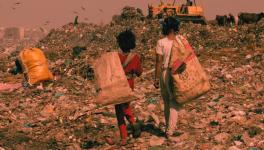Worldwide Food Inflation is Expected to Rise Steeply, Adding to the Woes of the World’s Hungry

On 22 April, Indonesia announced a ban on palm oil exports to check domestic prices of this crucial edible oil. The ban is likely to continue as the Joko Widodo government has repeatedly failed to control its prices. The decision immediately put Indian edible oil importers and traders in a fix. India currently imports 45% of its crude palm oil and 70% of RBD or Refined Bleached Deodorised palm oil from Indonesia. Most palm oil is imported in its refined form.
Reports confirm sudden spikes in edible oil prices as the cost of shipping and insurance drive prices up. They also say India’s edible oil import bill could rise by $2 billion. Oil importers and traders are in a tizzy, continuously searching for alternatives worldwide.
Given that palm oil is a component of biodiesel and used in industries such as cosmetics, prices of downstream items may also rise in India. Palm oil is primarily used in the processed food, restaurant and hotel segment, but the paints and chemicals industries also rely on it. Therefore, any shortage will impact prices across the board, not just in food. The first symptom of the coming crisis is that the domestic retail prices of edible oil have started climbing.
India has been on a hunt for alternative sources of cooking mediums, but multiple global uncertainties are coming in the way. Ukraine is a leading global producer of sunflower and rapeseed oil, but the ongoing war with Russia has affected both supplies. Western sanctions on Russia have also impacted supplies and prices. Another factor is the weather-related developments in Latin America and North America over the last year. Brazil, the world’s third-largest producer of maize, has suffered an extended drought that has affected crops. Recent predictions of maize production are not encouraging. Wheat production worldwide has also been impacted, as has its global movement.
The edible oil problem is not limited to palm oil. India procures 70% of its sunflower oil from Ukraine. Its prices spiked by $500 a tonne, and imported soy oil also became dearer in March, from $1,500 a tonne to $1,800 a tonne. In March, the Economic Times reported, Indian traders bumped up palm oil imports from Indonesia to tide over the disruption in sunflower oil imported from Ukraine. With palm oil exports barred from Indonesia, India has reached out to Argentina, a top producer of soy and corn.
India has offered Argentina special trade concessions if it curtails its 30% export tax on crude sunflower oil. However, in Argentina, both soy and corn crops were hit by the prolonged La Nina spell that withered much of its standing crops. A key Argentinian official has said the ability to export edible oil is not unlimited.
Corn, maize and soy are primary ingredients of poultry and cattle feed. Now, the Indian poultry and meat industries have expressed concern over low availability and rising feed prices. The industry has appealed to the government to release its inferior quality wheat stocks for use as feed.
These developments show that whatever quantities of these commodities reach India, they will be more expensive than earlier.
India also sought to import more soybean from Brazil, the most prominent global producer. This, too, was thought of as an alternative to Ukraine’s sunflower oil and Indonesian palm oil. It is important to note that palm oil is far less expensive compared to sunflower oil or soybean oil, so the hotel and restaurant sectors would not migrate to sunflower oil purchases at a premium.
India currently imports well over half its edible oil from overseas, led by palm oil and followed by soybean and sunflower oil. The more the conflict in Ukraine lasts, the bigger the drop in supplies and hike in prices. Earlies this week, cooking oil prices came close to Rs. 190 a litre, a 20-30% hike compared to before the war.
At present, 30% of the world’s wheat supply is in a dilemma due to the conflict in Ukraine, causing food shortages in many parts of the world. In India, the central wheat-producing states, Punjab and Haryana, have experienced significant harvest losses of up to 20% due to the early and intense hot weather season. Government procurement has fallen in both states. There are possible concerns that some farmers and traders will try to reap profits as long as shortages are expected. A spin-off of these shortages is the anticipated lag in fertiliser supply compared to demand. It may even make the Rabi sowing difficult unless supply lines are restored sooner rather than later.
DAP prices were at an all-time high during the last Rabi season, and farmers complained of non-availability and black-marketing. This shortage could be why the wheat harvest is lower than expected.
The silver lining is the bumper mustard crop in India, but that is insufficient to take care of the rising food inflation. Price surges have a spillover effect on demand as once purchasing capacity comes under pressure, the economy enters turbulent times. Escalating fuel costs have already hurt Indian farmers and consumers, for high fuel prices directly hurt food production. Every aspect of industrial and chemical agriculture depends on fossil fuels, from fertiliser production to tractors and harvesters. Last week, the government increased the fertiliser subsidy for this year in an apparent effort to try and control food prices. The cost of making industrial goods is affected by petroleum and natural gas prices.
So, from cereals like wheat, corn and maize or cooking oils from palm oil to rapeseed, sunflower, or even meat, the scenario is turbulent and seems to be getting worse. One effect could be a smaller food budget for families at the bottom of the income pyramid. However, this means a fall in nutrition standards, something India cannot afford to risk.
The author is an independent agri-policy analyst and writer. The views are personal.
Get the latest reports & analysis with people's perspective on Protests, movements & deep analytical videos, discussions of the current affairs in your Telegram app. Subscribe to NewsClick's Telegram channel & get Real-Time updates on stories, as they get published on our website.























